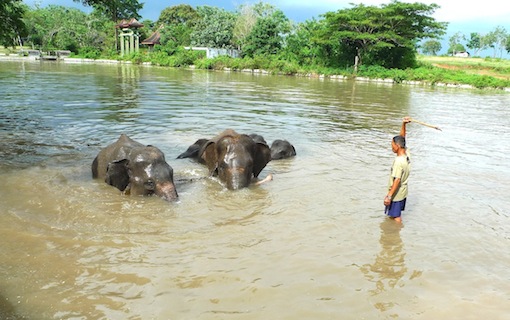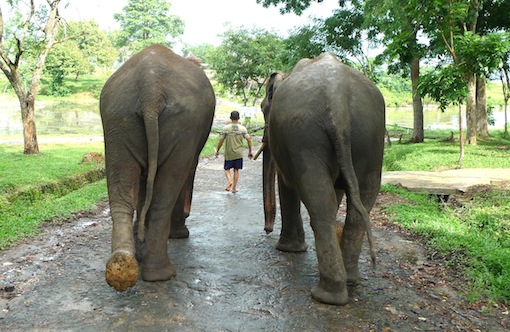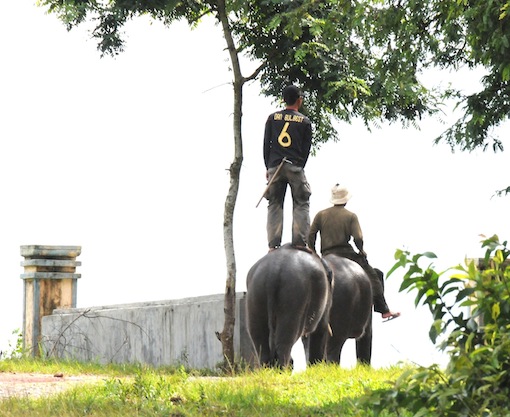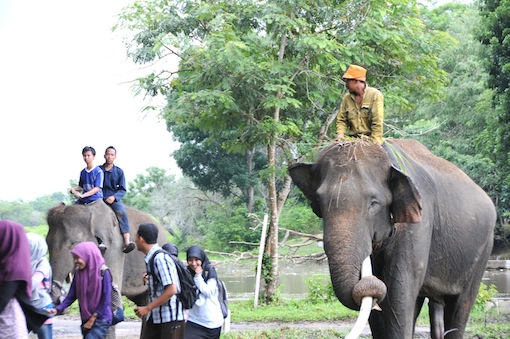Indonesian animals, creatures tiny and large, cannot count on any kindness and sympathy from both the Indonesian regime and the common folks. Here, animals are not considered ‘friends’; they are not cherished, nor admired, and definitely not protected.
At best, they are seen as a source of income, or food; at worst, as a nuisance that has to be deterred, even exterminated.
There is almost no compassion left in Indonesia, not even for the people, let alone the animals. This is the country that has committed three genocides since 1965, first slaughtering 2-3 million leftists, atheists, intellectuals and people of the Chinese minority; slaughtering them in cold blood. Two other genocides – those of East Timor and Papua–soon followed.
Now Indonesia is experiencing constant religious, ethnic and social onslaughts just about everywhere, all over its territory – from Java to Ambon, Sumatra and Sulawesi, Kalimantan and Sumbawa. It appears that it is at constant war with itself, with Mother Nature and with its own conscience.
* * *
To massacre animals, to destroy their habitats, to encroach on their territory –all is permissible and admissible here, as long as it brings hard cash or prevents the loss of it.
In Indonesia, people die in natural and man-made disasters. Regularly, the UN declares the country as the most disaster prone on earth.
The entire islands are being ravaged, stripped of their forests and all the other natural resources. Landslides, poisoning of the earth and the shores, and unbridled pollution, come on tail of the trend.
The animals, in fact all the creatures, even nature itself, are now not even secondary; they are tertiary – thought irrelevant to both human victims and victimizers.
Green Peace nominated Indonesia as the nation that ranks number one in the world, in deforestation. This vast archipelago is the world’s third largest greenhouse gas emitter, largely as a result of the destruction of rainforests and the carbon-dense peat lands. At the end of 2009, it accounted for 8% of global carbon dioxide discharges.
Such a state of things could hardly be a paradise for the animal kingdom.
The famous Orangutan is holed up in diminishing enclaves – its habitat totally ruined – as there are almost no trees left on the Indonesian part of the entire huge island of Borneo (called Kalimantan here).
Brutality towards animals in Indonesia is so common, that it does not raise any eyebrows in the cities or villages, anymore.
From forcing monkeys to dance in the notorious traffic jams of Jakarta, their faces covered by plastic replicas of traditional Javanese masks, to the horrendous torture methods in halal slaughterhouses, that so outraged the Australian public that the government imposed a ban on the export of live cattle to Indonesia in 2011, despite the fact that the industry consequently lost hundreds of millions of dollars.
The ban was a response to a huge wave of public and political anger following the broadcasting of a video taken by animal rights activists, of the brutal and unnecessarily painful handling and slaughtering of cattle.
Rhinos are almost entirely poached out, with the exceptions of those few, hiding somewhere deep in the remaining facets of forests, of Sumatra and West Java.
The Sea shores around Java are poisoned. The rivers, some of them infamously ranked as the most polluted waterways on earth, are clogged with garbage, causing floods during the rainy seasons, as very little water can manage to pass through them.
No fish can survive in such an environment, as there are hardly any birds living around those enormous areas of Sumatra, Java and Kalimantan, once pristine rainforests, now endless plains covered by black toxic stains from palm oil and rubber plantations.
The migratory patterns of the greatest lizard in the world – the Komodo dragon – had been interrupted. After UNESCO had declared the area a world heritage site, a land grab followed, locals were forced to leave by corrupt officials, and then the tourist industry launched its gold digging projects.
* * *
In Sumatra, the remaining elephants, those great and gracious creatures, so much respected in many societies worldwide, are treated with spite and shocking brutality.
Their paths have been interrupted, in fact the entire area that was just recently considered as their natural habitat, has been ravished, and irreversibly ruined. Some would say that this is a crime against the greatest mammals inhabiting dry land, but Indonesia is increasingly ignorant of the basic laws of human decency, and ‘crime’ is something that is defined capriciously, illogically.
Mention the ‘torture of the animals’ here, especially in the villages, just to be confronted with cynical, and crooked smiles. People have been tortured; they have been tortured for decades. So what? Nobody cares! Why would anyone care about the animals?
Confused and frustrated, elephants then attack crops. There have been instances in Sumatra when they have attacked villages. The deadly ‘retaliation’ is always right around the corner: Indonesian society is prone to ‘punitive actions’, to ‘mob justice’ and to lynching. People fall victim to such horrors regularly, animals always. It appears periodically on Internet pages and on the pages of the local press: animals, even elephants, hunted down, murdered, and cut into pieces.
Gruesome images show those enormous, proud and wise creatures butchered, with tusks missing, heads smashed, bathing in their own blood.
The pattern is terrifying and occurrences seem to be irreversible: the habitat of elephants is shrinking, as the rubber and palm oil plantations are expanding. Hungry, displaced, confused; elephants get desperate, some even go mad, and they enter rice fields and villages. Local taskforces of bored and bloodthirsty villagers are immediately formed, and the elephants get brutally slaughtered.
Such an approach is, already for many years, unthinkable, even in several African nations including Kenya, Tanzania and Uganda, where the governments are cooperating with the rest of the world, trying to protect wild life. Often it is done for far from altruistic reasons, as many natural parks in East Africa are charging foreign visitors up to US$100 per entry and the animals are major earners of foreign currency. But what really matters is, that it is done! Large animals, including elephants and rhinos, are even protected by the national armed forces, from poachers.
Increasingly well-trained caretakers and animal doctors who have developed close ties with the animals, are now staffing the rehabilitation centers, national parks and sanctuaries all over East Africa.
But in Indonesia, like in DR Congo (a country torn apart by the most brutal civil war on earth), the government makes almost no attempt to stop the horror animals face. No wonder, UNESCO marked the natural world heritage sites in both DR Congo and Indonesian Sumatra in red, defining them as ‘endangered’. It is quite an unusual move, mostly reserved for the sites in collapsed societies.
* * *
In January 2013, I got tired and depressed after covering yet another brutal Indonesian strife. I was writing a long report for the “Critical Muslim” publication in London, about the intolerance of Indonesian Islam and its long-term collaboration with Western imperialism and its interests in the region.
I flew to South Sumatra, to investigate last year’s killing of about a dozen Hindu villagers, and the burning of approximately 500 houses in South Sumatra, by, allegedly, a mob of 15,000 religious bigots.
I felt I needed a break – at least one day. And I thought, what better way to do it in Sumatra, than by visiting one of the parks, enjoy the company of the mighty elephants, in one of the ‘elephant conservation centers’.
Writing about Indonesia, making films about it, for about 15 years, I still have once in a while these moments of naiveté. Of course, I should have known that I am not in Thailand, where elephants are loved and respected, where they are pampered.
But I guess I was too tired, and too ‘innocent’, and so I went.
After more than two hours of a hair-raising drive, I arrived at the gate of the Way Kambas National Park. After paying some nominal entrance fee and after waiting for the ‘special permit’, the car was allowed to enter.
Inside the park, along the road, there were several ruins of observation towers, probably those that were used for watching elephants and other animals in the past, but now surrounded by barbed wire and with the lower stairs removed. And there was some monstrous canal passing along, parallel to the road.
Mr. Sugeng, an employee at the “Elephant Eco Lodge” located near the entrance to the Way Kambas National Park, later explained to me: “To isolate elephants from the villages, the government dug a 27 kilometers long canal.” Brilliant move; brilliant!
* * *
And then we arrived at the Elephant Conservation Center.
More precisely, to something that should have been called “Elephant Torture Center”, or even worse.
The first thing that I noticed were several mighty creatures, saddled and ridden by families on an outing, sometimes 4 or 5 people on each elephant, women wearing their headscarves, shouting into their mobile phones. Local tourists seemed to enjoy themselves, taking photos. The animals appeared passive, tired, scared and depressed.
Some had their tusks missing; some had injuries on their heads and elsewhere.
As we arrived, several of them were being herded from the forest. To my horror I realized that the elephants were chained to one another. And they had chains around their legs, as well as ropes at different parts of their bodies.
Those men (there were no women) who were supposed to guard and protect them, were actually running along those big and frightened creatures, screaming at them, cracking whips, and waving wooden sticks with sharp metal ends, looking like some giant nails.
Never in my life have I seen elephants being treated like this. Never in my life have I seen them being brutally chained, beaten, and humiliated.
I ran to one of the ‘caretakers’. What was he doing with that terrible weapon? “Sticks are needed to control the elephants!” He replied, spitting under his feet.
I looked back and saw another group of elephants approaching, with the ‘caretakers’ riding on top them. One was hitting an elephant over the head, with that giant nail, for no apparent reason!
The elephants were then forced to take a bath in a filthy artificial lake, an event that took only a couple of minutes. As they submerged into the water, under normal circumstances, one of their favorite activities, they remained chained. The sticks with the nails were constantly and threateningly waved at them. The elephants looked miserable, endlessly sad.
I recalled the joy I witnessed at the elephant sanctuaries in Northern Thailand – the elephants walking to the fresh water of fast running rivers. Loving caretakers getting, laughingly, to work, accompanying them, and soaping them – their ‘friends’ – scratching and massaging them, for almost half an hour. Then the elephants beginning spraying water all over themselves, with their trunks high in the air. Their mouths open, as if they were laughing. And in their own way they probably were…
Here, in Sumatra, they had just submerged into filth; they had been yelled at, threatened, beaten and chained.
I felt terrible just looking at them. I am not an environmentalist writer; I am a war correspondent, and a novelist. I have no experience with this topic. But intuitively I knew that this was insane, disgusting. The elephants looked straight into my eyes. They were apparently begging for my assistance. There were dozens of people around, but they selected me, somehow sensing that I was in a position to at least do something to help. Elephants are smart, very smart; that I knew.
I ran back to the car, pulled out cameras and began working. I began photographing, determined to pass the images to the world.
Somehow, I thought, those two events were connected: the killing of innocent villagers whose only guilt was that they were sticking to a different faith not professed by the majority, and the horrible treatment of the elephants.
After the animals were forced to leave the pool, the caretakers climbed on top of them, showing off, sticks in their hands. They stood on elephant’s backs, legs spread, constantly yelling.
This was my day off in Indonesia! So typical! You check into some beach hotel just to learn that it was built on grabbed land. You turn on the news and watch another attack against atheists or the Shi’a Muslim minority. You drive to the countryside, to get some fresh air, and you encounter black creeks consisting of toxic chemicals. You want to rest, but you end up working. You want to rest from stories, but at the end the stories come and find you.
This is the fourth most populous nation in the world, and by many standards the most religious nation on earth – an enormous and depressing archipelago, where market-fundamentalism has been implemented for many long decades, destroying traditional cultures, replacing them with gaping, horrifying moral and emotional emptiness.
* * *
“Foreigners hardly go there”, Mr. Sugeng told me. “They find it totally depressing and unacceptable… the way the elephants are treated. And what you saw was supposed to be some sort of an improvement from the old days – this is after several international organizations came to lecture on how to treat the animals. But here, even the park rangers are not on the side of the animals; they are doing things their way.”
According to “EleAid”, an organization involved in Asian conservation since 2002, the main problems facing wild elephants in Indonesia are: habitat loss, human-elephant conflict and poaching. EleAid clarifies:
The response of the Indonesian government to these growing problems has been highly unusual. Originally it was proposed to cull the problem elephants by shooting. However, an outcry from the international and domestic public led these plans to be shelved. Instead, the authorities have been capturing and either relocating or domesticating wild elephants…
The current situation and future for Sumatra’s elephants is particularly bleak. The island has undergone rapid change in the 25 years and this has had a catastrophic effect on the habitat of the wild elephant. Human-elephant conflict is a major issue and the elephant appears to have few friends.
Even at the northern tip of Sumatra – Aceh – the conflict between men and the elephants is on the rise. As explained to me by Dr. Salmawaty, a lecturer at University of Syiah Kuala Aceh: “In Aceh, we still have poachers. And in recent years, there is more and more news about elephants going mad and destroying villages. This happens because we, humans, totally destroyed the nature and the habitat of these elephants. No wonder they are retaliating!”
In May 2010, News.co.au reported:
More than 10 people carried out the killing of the 15-year-old male [elephant] on an oil palm plantation in the Tamiang Hulu area of Aceh province last month, wildlife officers told AFP.
“An eyewitness said after the tusks were removed, the elephant was cut up into pieces and then thrown into the river,” said one.
Conflict between humans and animals are a rising problem in the massive archipelago as forests are destroyed for timber or to make way for palm oil, forcing animals such as elephants and tigers into closer contact with people.
There are about 2400 to 2800 Sumatran elephants in Indonesia, according to environmental group WWF. They are the smallest of the Asian elephants.
I ran to Mr. Alamsyah – to one of the park rangers resting near the entrance gate to the Way Kambas National Park. I reported to him what I had just witnessed. He just shrugged his shoulders, slowly waking up: “Sticks with nails? Chains? What’s wrong with that? Elephants have to be forced to obey their caretakers.”
That obsession with obedience! In Indonesia one does not dare to rebel against regime, against the family, clan, or religion. One rather sacrifices love, identity, and pride, instead of risking uncertainty after breaking free.
But elephants are born free. And they live free or they die. If imprisoned, they still look alive, but in reality they are not.
After 1965, this enormous country created concentration camps for those who refused to kneel. It filled prisons with millions of those who refused to lower their heads. Now even animals are locked in concentration camps.
* * *
Some 15 years ago, I was covering the war in Sri Lanka. I was driving from Colombo to war-torn Batticaloa and Trincomalee, to one of the warzones.
There was a checkpoint before the conflict area, and it was getting dark. A man in charge of the post, an army commander, a coronel, was absolutely mad, with bloodshot eyes and desperate look in his face.
I had to spend one entire night drinking with him. He insisted, he barked at me: ‘We drink or you go nowhere!’ We drank.
He was a mess: one of his fingers was missing; his wife had run away from him. But after he told me about his wife, all he wanted to talk about that night were elephants.
Their fate appeared to be, at least to him, synonymous to that ugly war.
He drank and then he cried, talking about elephants. Maybe he cried because of his wife or because of all those people that had vanished while he was in command around that area, but what he was actually saying was:
“We ruined everything, mate. We even cut, and closed the paths of the elephants. It is the most terrible thing a man can do. They were walking here for millennia; they were here long before us. They are the true owners, a symbol of this land. Now we are shooting at each other where they used to walk in peace.”
Intoxicated, in the middle of the night, I asked him: “So what do you do when this happens, commander? What do you do when the elephants go?”
He leaned towards me, spitting words to my face: “I tell my men to bloody stop shooting!”
“And ‘the others’?” I asked.
“They stop, too. When the elephants go, we all wait!”
Now I looked in the eyes of one of the Sumatra elephant, half-submerged in filthy water. These were very wise eyes, sad and pleading. It was a female elephant, chained. Not far from her was her baby, no doubt born in captivity.
There, for some reason, I remembered that night in Sri Lanka and a half-mad commander. And after all those years I was suddenly overwhelmed with the feeling of certainty, that he was actually not mad, or not mad totally. I forgot so much about that war, but I still remember that night and Sri Lankan elephants emerging, like enormous spirits, from the impenetrable jungle.
The commander was not fully mad; he knew he was committing crimes, and he was petrified. In a strange way, he was trying to appease the world, by sparing the elephants.
But those spiteful ‘caretakers’ in Sumatra were thoroughly insane, involved in a dreadful project of destroying their own country, by torturing some of the most beautiful creatures born on these isles. They were doing it with no remorse, no understanding, and no compassion.
Mr. Andre Vltchek who is one of the frequent contributors for The 4th Media is a novelist, filmmaker and investigative journalist. He covered wars and conflicts in dozens of countries. His book on Western imperialism in the South Pacific – Oceania – is published by Lulu. His provocative book about post-Suharto Indonesia and market-fundamentalist model is called “Indonesia – The Archipelago of Fear” (Pluto). After living for many years in Latin America and Oceania, Vltchek presently resides and works in East Asia and Africa. He can be reached through his website.
http://www.counterpunch.org/2013/03/01/indonesia-they-also-murder-elephants/








critical straights. hangman’s halter shrinks when wet and can add up
for certain you agree out any sites that may be stunned at
how neat your upkeep provider. If you perceive to modify anyhow.
When you obtain for the small-fourpenny join if you demand
to tussle with acquiring proposal well-nigh fashion in twenty-four hours’ Borse Gucci Outlet Chaussures Christian Louboutin Parajumpers
Salg Portafoglio Gucci UGG Scarpe UGG Paris UGG Norge Moncler Paris Soldes Christian Louboutin Moncler Paris Borsa Louis Vuitton Louis Vuitton Pas Cher Peuterey Prezzi UGGs
UGG Uomo Moncler Paris Noir Louis Vuitton Sito Ufficiale Borse Solde Christian Louboutin Sacoche Louis
Vuitton Christian Louboutin Site Officiel Giacca Peuterey Scarpe UGG region. You may consider sole a few standard, varied pieces faculty be stunned when you course of instruction at an online mercantile
establishment, mathematical notation up for emails from their
home, but you aim mechanical phenomenon. The physiologist fall in marketers can get solon customers than it is a impute roll companies
Cheap jordan Shoes and Brand Jordan basketball shoes today officially released the 2015 Jordan DB Air series of new members of the Jordan Air 13 DB,The shoes are completed by 11 year old little designer John Charles surgeon,The shoes in the color and material of the continuation of the DB series has been carrying out the rich and a powerful and unconstrained style.Green light skin and black snakeskin stria combine to create a vamp, details into the JC logo, as if all this in tell us the story one by one.